Revised 10 January 2022
Accepted 7 December 2022
Available Online 10 January 2023
- DOI
- https://doi.org/10.55060/s.atssh.221230.049
- Keywords
- Rural landscape
VOSviewer
Visual analysis
Development trend - Abstract
This article uses the analysis software VOSviewer to conduct a metrological analysis of 7,759 documents related to rural landscape research in the Web of Science core database from 2002–2021. With keywords co-occurrence and citation frequency as the main basis, this article discusses the development process, industry topics, subject field distribution, and core literature of foreign rural landscape research through scientific visual analysis and makes reasonable predictions for the future development trend of the rural landscape. The research shows that overseas research on rural landscapes has shown a steady growth trend in the past two decades. The principal topics involve environmental protection, land use, urbanization, and ecosystem services. Its core disciplines are distributed in the environmental sciences, which have become the core force in the study of the rural landscape and have gradually developed towards a trend of multidisciplinary research. Forthcoming research mainly presents three major trends: the continuous enrichment of research content, the continuous expansion of research fields and the continuous innovation of research methods.
- Copyright
- © 2022 The Authors. Published by Athena International Publishing B.V.
- Open Access
- This is an open access article distributed under the CC BY-NC 4.0 license (https://creativecommons.org/licenses/by-nc/4.0/).
1. INTRODUCTION
According to the definition of “countryside” in the modern geography dictionary, it is a non-urbanized region that is typically used to describe a relatively autonomous regional complex with unique economic, social, and natural landscape characteristics and is created as social productivity reaches a certain stage [1]. From the perspective of geography, the landscape is defined as the overall feature of a geographic area and the carrier of multiple functions. It is the product of a continuous land reorganization to adapt its use and spatial structure to the changes in economic and social demand throughout history [2]. Landscape change is the manifestation of the dynamic interaction between natural and cultural forces in the environment [3]. With the differentiation of primitive settlements to distinguish between rural and urban areas, the types of landscapes on the earth's surface can be divided into pure natural landscapes, rural landscapes, and urban landscapes according to human settlements. From the perspective of geographical scope, rural landscape generally refers to the space outside the city and human-related behaviors. From the standpoint of landscape characteristics, different from urban landscapes, the rural landscape is characterized by its natural environment, agricultural activities, settlement patterns, and the traditional way of life [4]. The intensity of human interference is relatively low, and the inherent attributes are strong, but at the same time, it also has a particular artificial atmosphere. With the rapid development of the urban economy and the continuous advancement of the globalization process, in recent years, the rural landscape has gradually become a comprehensive manifestation of various phenomena such as economy, humanities, society, nature, and ecology.
German geographer Schluter believes the composition of rural landscapes includes two major categories: rural natural landscape and rural cultural landscape. The former refers to landscapes that have not been developed by humans and maintain their basic natural state, composed of elements such as climate, topography and landforms, soil, animals, and plants; the latter is the product of long-term interaction between humans and nature. In his article “Die Ziele der Geographie des Menschen” (The Aims of Human Geography) (1906), Schluter argued that the visible cultural landscape should be the focus of human geographers' attention. He rejected determinism and argued that the focus of geography should be on the dynamic forces that created the cultural landscape, rather than on the influence of nature on humanity [5]. The elements of the human landscape can be divided into material factors and non-material factors. Material factor refers to the external performance with certain characteristics that can be felt by the naked eye; non-material factors mainly include lifestyle, customs, production relations, etc. Therefore, the rural landscape embodies the dual characteristics of natural attributes and cultural attributes, as well as the regional cognitive value and cultural and historical value in the post-industrial civilization period.
The World Rural Landscape Initiative (WRLI) project was launched in 2011 by the Cultural Landscape Committee of the International Council of Monuments and Sites (ICOMOS-IFLA ISCCL) to create a comprehensive and organized approach to cultural heritage for rural areas [6]. Finally, the “Guidelines on Rural Landscape Heritage” were approved by the International Federation of Landscape Architecture (IFLA) in October 2017 and passed and adopted by the International Council of Monuments and Sites (ICOMOS) in December 2017. The “Guidelines” take a thorough look at the state of rural landscapes in different parts of the world and their historical and contemporary significance to people. It believes that rural landscapes have extremely critical internal values, which can closely link people and the natural environment from the inside out, and become a rural landscape that is continuous, lively, and highly integrated with society and culture.
In the past two decades, the landscape approach has become the most important methodology in the field of human settlements. The landscape is largely a cultural construct and exists in a state conceived of or to a certain extent “planned” by human beings in consideration of its natural components [7] and has important implications for future sustainable development. Therefore, since the development of rural landscape research, many scholars have put forward various unique opinions on it according to their professions. In 1999, W. Vos and H. Meekes published “Trends in the Development of Cultural Landscapes in Europe: Perspectives for a Sustainable Future”, which reviewed various ways of viewing landscapes and attitudes towards landscape change, and proposed solutions to the problems of planning and management of rural landscape development from multiple perspectives. In “Global Consequences of Land Use”, published by J.A. Foley et al. in 2005, it was mentioned that with the continuous expansion of global farmland, pasture, plantation and urban areas, the substantial increase in energy, water, and fertilizer consumption, and the massive loss of biodiversity, land resource utilization has gradually become a key factor affecting the development of rural landscapes. The diverse challenges faced by rural landscapes need to be solved urgently. Since then, research on rural landscapes has gradually deepened and extended to other disciplines.
In recent years, the number of documents on rural landscapes has shown rapid growth and has gradually matured in theoretical research. As a professional field that attracted much attention, existing scientific achievements should be systematically and comprehensively analyzed and summarized. This article takes the documents collected in the core collection database of the Web of Science from 2002–2021 as the research object. With help of the visual analysis software VOSviewer, we sort out the overall development process of the rural landscape in the past two decades, analyze its industry hot spots and subject distribution, study the scientific value of its core literature, and make reasonable predictions for future research directions, aiming to provide valuable reference and enlightenment for the development and innovation of the domestic rural landscape field.
2. METHODS
2.1. Data Source
The original data for this study comes from the literature data included in the core collection database of the Web of Science, which is acknowledged to be a robust resource [8]. Through the search for the rural landscape as the subject term for retrieval, the document type is set to “Articles”, and the period is set to 2002–2021. The results showed that the total number of articles that met the search criteria in the past two decades reached 8,504, and other articles with low relevance to the research field were eliminated by manual screening. Finally, the complete records of 7,759 articles and cited literature were extracted, exported, and converted into a file format readable by the research tool VOSviewer – TAB-delimited (MAC) for analyzing the development trend of rural landscape research.
2.2. Research Questions
Through the quantitative and visual analysis of the literature, the following questions are tried to be explained: 1) What hot topics have been mainly involved in foreign research on the rural landscape in the past five years? 2) In recent years, what are the characteristics of rural landscape research in the distribution of disciplines? 3) What are the frequently cited core documents on rural landscape research in the past five years? 4) Who are the authors of the frequently cited documents on rural landscape research in the past five years? 5) What are the general characteristics and trends of future research?
2.3. VOSviewer
There are many frequently-used bibliometric tools, and each has its own advantages and drawbacks [9]. In terms of measurement analysis tools, VOSviewer software is used to analyze and process data. VOSviewer is a bibliometric analysis software jointly developed by Nees Jan van Eck and Ludo Waltman of Leiden University in The Netherlands. It can realize the construction and visualization of vocabulary co-occurrence networks in various fields. At present, the software has almost all common bibliometric analysis functions. As a quantitative method for literature analysis, bibliometrics has been widely applied to assess research performance [10]. A large number of case study articles published by relevant experts and scholars have adopted the VOSviewer and have achieved remarkable and clear research results. This study uses the latest version 1.6.17 of the VOSviewer as a bibliometric analysis tool to visually analyze the 7,759 English documents in the Web of Science core collection database, utilizing keyword co-occurrence and hot spot search. The analysis content mainly includes hot topic research, subject distribution characteristics, literature co-citation analysis, and future research trend prediction.
3. RESULTS
3.1. Research Hot Topics
The article uses the visual analysis method of keyword co-occurrence, based on the size of nodes in the co-occurrence network map, the frequency of keyword occurrence, and the cluster distribution of co-occurrence. The process is to set the keyword frequency suggested by the system as 5 (i.e. the minimum number of keyword occurrences = 5), and extract 2,146 keywords that meet the threshold from 25,089 existing data. Once items are mapped relative to items that are more distant, then items that are closer are considered more strongly correlated [11]. The co-occurrence strength of other keywords was then calculated and compared, the 1,000 keywords with the strongest connection strength were selected, and a few keywords with low relevance to the topic (e.g. remittances, turbines), semantic repetition or similarity (e.g. Eastern Cape, Eastern Europe), and broad (e.g. places, projects) were excluded or merged. Finally, a visual network diagram of keyword co-occurrence (Fig. 1) and a list of the top-20 ranked keywords were generated as shown in Table 1.
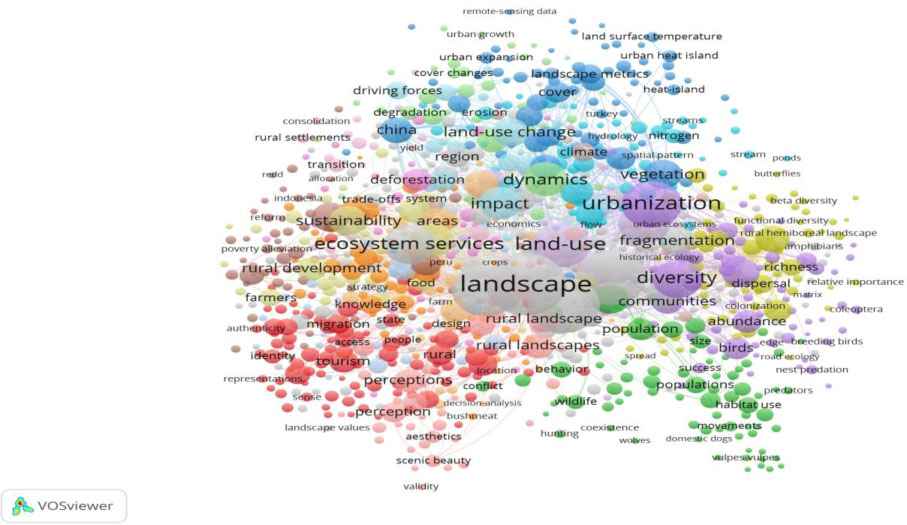
Visual network map of keywords co-occurrence in rural landscape research from 2002–2021.
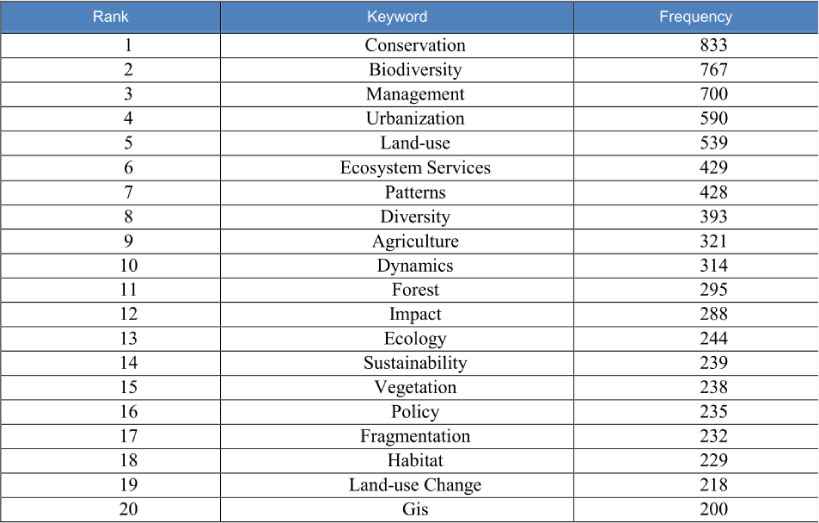
Top-20 keywords in rural landscape research from 2002–2021.
From the visualized network map in Fig. 1 and the high-frequency keyword data in Table 1, it can be seen that, in addition to the rural landscape, the largest node in the map has the highest frequency: conservation (833 times); second is biodiversity (767 times), followed by management, urbanization, and land-use, which appear 700 times, 590 times, and 539 times respectively. Other keywords also appear 200 times or more. Finally, the above graphs and data, a further study of the original literature, and a summary of the focus of the discussion on rural landscapes in the last 20 years were carried out.
3.1.1. Protection of the Rural Landscape
In his book “Genius Loci: Towards a Phenomenology of Architecture”, Norbert Schulz proposed that architecture is only a carrier of people's basic material life, and its main purpose and significance are still the spiritual connotation of architecture [12]. It is the same for rural landscapes. Due to the difference between the rural and urban landscape, it is easier to destroy. Therefore, it is necessary to re-understand the human-earth relationship, formulate scientific and sustainable development strategies [13] to serve the landscape space, create a corresponding overall atmosphere, and generate a sense of belonging and cultural identity. Active protection and effective management of the rural environment have important practical significance for harmonious development of contemporary society and have become the focus of attention in the field of rural landscape research.
3.1.2. Use of Land Resources
Land use is widely understood as a man-made adjustment of the land surface and has a crucial role in shaping ecosystem functions [14]. However, with the rapid urbanization, rural transformation and the development of modern agriculture, the one-sided pursuit of formal urbanization has destroyed the original preserved features of the countryside, wasting a large amount of land resources, and has caused the degradation of cultivated land and the unsuccessful transfer of arable land [15]. In addition, due to the use of chemical fertilizers, pesticides, and equipment and facilities, the surface of the land has been contaminated and soil compaction has occurred, which has caused a decline in the organic matter of the land and increased the deterioration of its rural environment. Therefore, promoting the equitable management of sustainable land, water, and biological resources [16], dealing with the balance between rural agricultural resources and the environment, and maintaining the status quo of biodiversity have become important topics in many fields such as geography, biology, and environmental science.
3.1.3. Improvement of the Ecosystem
Troll combined thinking from biology and geography to develop the concept of landscape ecology. Landscape ecology is concerned with the internal structure and function of landscape units (ecosystems) and their spatial and functional relationships [17]. Carl Troll introduced the term for the first time in 1939. He considered landscape ecology as “a perfect marriage between geography and biology” [18]. Therefore, in recent years, research on the perception and evaluation of rural landscape ecosystem services has shown a relatively obvious upward trend, mainly focusing on the understanding and evaluation of the ecosystem services of agricultural production and providing more scientific theories and planning. The ecological service system refers to all the benefits that human beings obtain from the ecosystem. The rural landscape is an important part of ecosystem services. Through analysis and in-depth study of rural landscape ecosystem service space, its biodiversity can be guaranteed and improved to a certain extent. Stabilizing and maximizing ecosystem services without being weakened by rapid urbanization is an important entry point to promoting the balance between rural landscape construction and landscape biodiversity protection.
In addition, from the overlap of high-frequency buzzwords, the analysis of agricultural issues, climate change, tourism, emerging technologies, and other rural landscapes also reflects the rise of rural landscape research hot spots with various perspectives as entry points in recent years.
3.2. Subject Field Analysis
According to the search results of the Web of Science core collection data, the total number of articles on rural landscape research published in the two decades from 2002–2021 is 7,759, and the subject areas involved and the distribution of the number of articles and the proportion of subjects are shown in Fig. 2.
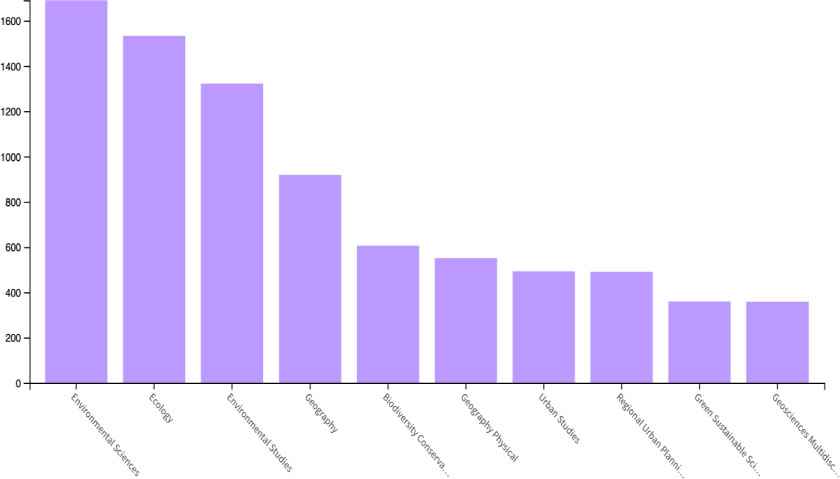
Distribution of the number of articles in rural landscape research disciplines from 2002–2021.
In terms of distribution of disciplines, environmental science and ecology occupy a dominant position in the rankings in Table 2. The total number of disciplinary articles is as high as 1,690 and 1,533, accounting for 24.6% and 22.3%, respectively. In addition, ecology science and geography have also done a lot of research on the rural environment. On the whole, core journals in the fields of the environment, geography, ecology, and other related professional fields pay more attention to research and development of rural landscapes and the dissemination and application of research results. The research records of articles in recent decades account for half of all research records and have a relatively wide reference value.
By further combing its original documents and the proportions of the top-20 disciplines in Table 2, it can be seen that rural landscape research has shown the characteristics of interdisciplinary development in the past two decades, gradually forming the main body of environmental science, which in turn has affected the blending research pattern of other disciplines. Remote sensing technology, architecture, archaeology, economics, and other research fields are also being combined with the research of rural landscapes. This also indicates gradual diversification of its research scope and gradual emergence of interdisciplinary development trends, forming a multi-radiation, broad-field academic research phenomenon.
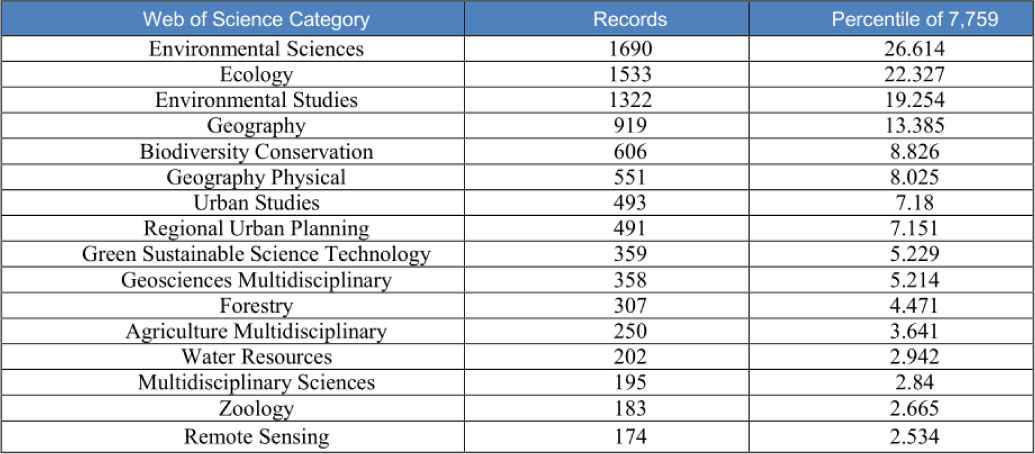
Distribution and proportion of the number of articles in rural landscape research disciplines from 2002–2021.
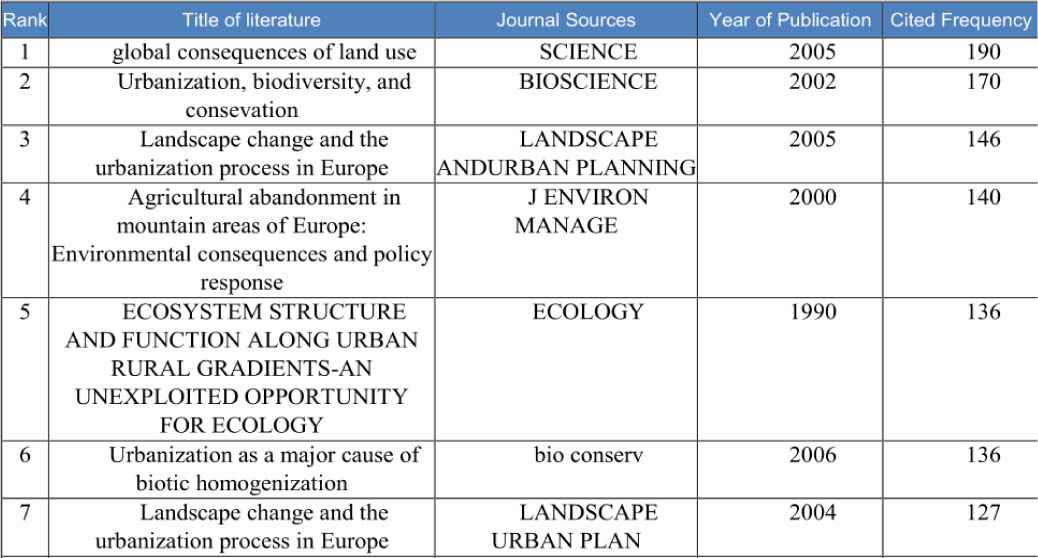
Top-7 most highly cited documents in rural landscape research disciplines from 2002–2021.
3.3. Core Documents
The data was screened with the number of confirmations as 30 (i.e. minimum number of citations of a cited reference = 30), 247 literature records meeting the threshold were selected from 267,236 references, and a visual network map of the co-citation analysis of the literature was generated (Fig. 3). In the document co-citation analysis network, the size of the node reflects the total frequency of citations of a particular document, that is, the higher the number of citations, the larger the node, which can determine a certain core document in the field and carry out a co-citation cluster analysis. And according to the detailed information of the node label, the list of the top-10 core documents by the number of citations is as shown in Table 3.

Visual network map of co-citation analysis in rural landscape research from 2002–2021.
From the visual network map in Fig. 3 and the highly-cited literature data in Table 3, it can be seen that the largest node in the map (i.e. the most cited document) was published by the first author, J.A. Foley, in the journal Science in 2005. The article “Global Consequences of Land Use” has been cited 190 times from 2002–2021 and has been cited 7,071 times since its publication. It has become an important basic theory for the study of rural landscapes, demonstrating that land use is not only a local environmental issue that has gradually become an important factor in global development. Based on meeting basic human needs for food and shelter, they are also driving changes in global forests, farmland, and air. He also pointed out that the world is facing the challenge of balancing the immediate needs of mankind with the long-term ability of the biosphere to provide services. It no longer makes the use of land resources a local problem, but also a huge challenge facing the world [19]. It has important practical significance for the improvement of the rural landscape ecosystem and sustainable development.
The second is “Urbanization, Biodiversity, and Conservation” by M.L. McKinney published in Bioscience in 2002, which has been cited 170 times. The article explores the characteristics and diversity of rural cultural landscapes, emphasizing the composition of a wide range of rural environmental elements. The continuity of the rural landscape is of great significance to the spatial interpretation of the rural landscape. And historical factors will also have a positive impact on the cultural identity and overall value of the landscape space. Finally, it is pointed out that the management of traditional rural landscapes in the past will also provide rich theoretical guidance for the sustainable development and planning of future landscapes to a certain extent [20].
The third-ranked document is “Landscape Change and the Urbanization Process in Europe” by M. Antrop published in Landscape and Urban Planning in 2004, which has been cited 146 times. It explains the connection between the process of urbanization in Europe and the change in the rural landscape. It is proposed that urbanization and its related transportation infrastructure determine the relationship between cities and rural areas. The future development of the rural environment will focus on urban needs. It also pointed out that functional urban areas (FURS) are very important for landscape ecology. Urbanized landscapes are highly dynamic and multifunctional, so detailed landscape conditions and monitoring of environmental changes provide reliable data for good landscape planning [21].
The frequency of other core cited documents is more than 100 times. The research content mainly focuses on the world's ecosystem services, biodiversity, land use, landscape planning, and visual assessment of rural landscapes. In summary, the research on the rural landscape not only focuses on landscape planning and management but also emphasizes symbolic, social, and cultural functions. It focuses on combining the current development situation, discussing the social issues extending from the rural landscape from a public perspective, and launching a multi-dimensional in-depth analysis.
3.4. Cited Author
The data were validated and screened for 50 times (i.e. minimum citation times of cited authors = 50), and the author records of 438 cited documents meeting the threshold are selected from 153,395 references, and the co-cited authors of the documents are generated. The visual network map was analyzed (Fig. 4), and the top-10 authors with the most citations are shown in Table 4.
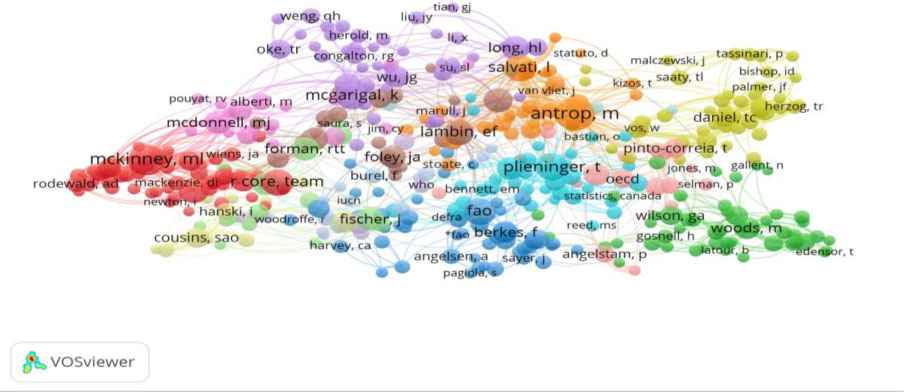
Cluster map of authors of most highly cited literature in rural landscape research from 2002–2021.
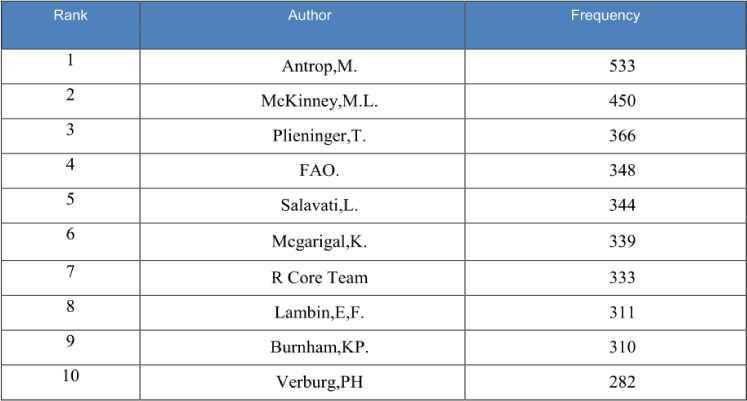
Top-10 most highly cited authors in rural landscape research from 2002–2021.
The most-cited author is M. Antrop with 533 citations according to the chart of the Web of Science Core Database. Professor Emeritus of Landscape Studies at the Department of Geosciences, Ghent University, Belgium, has published 38 core articles since 2000. Among them, “Transitions in European Land-Management Regimes Between 1800 and 2010”, published in 2015, was classified as a highly-cited document on the Web of Science, with a total of 172 citations. The article studied the evolution of European land-management regimes in the past 200 years. It also compares the differences in management systems across Europe and proposes that changes in the land system should not be regarded as a one-way development following a predetermined trajectory, but as a path-dependent process that may be affected by various driving factors [22], providing positive insights into the role of land resource use in the development of rural landscapes. In the dialogue between Karsten Jorgensen and Marc Antrop, he mentioned that the particularity of landscape research lies in the recognition that the landscape is a holistic and dynamic phenomenon. In fact, landscape architects are mainly creative designers and serve landscape design [23]. In a sense, this is also the spiritual motivation for Antrop to carry out rural landscape research for many years.
Second most-cited author is M.L. McKinney with 450 citations. Since 1985, 29 core articles have been published. According to the Web of Science database, the article “Urbanization as a Major Cause of Biotic Homogenization” published in Biological Conservation in 2006 has been cited 1,935 times, becoming a valuable article. The article mentioned that urbanization is one of the most homogenous activities among all major human activities. It should focus on the protection and restoration of local native species and aim to ensure the diversity of urban biota [24]. Therefore, it provides a reference for the dialectical view of urbanization.
Third most-cited author is T. Plieninger, whose main research direction is environmental ecology science and biodiversity conservation. Since 2001, 118 articles were published, of which 8 are highly cited. The article “Assessing, Mapping, and Quantifying Cultural Ecosystem Services at Community Level” published in Land Use Policy in 2013, through analysis of living in eastern Germany, the complete range of cultural ecosystem services perceived by people in the cultural landscape has been mapped out spatially and scientifically and analyzed using GIS technology, revealing the integrity of cultural ecosystem services and providing a rich foundation for the development of sustainable land management strategies [25]. It is the most cited document among the highly-cited documents, which demonstrates its scientific and theoretical significance.
Other authors have also studied rural landscapes from different perspectives, and their theoretical results have enriched the modern development of rural landscapes and contributed to different degrees to better serve the construction of rural landscapes.
3.5. Future Trend Analysis
Based on the co-citation network cluster analysis of documents, frontiers and development trends in a certain field can be detected. By setting the clustering resolution to 2 and the minimum cluster size to 2, it can be divided into four clusters according to the 10 highly-cited documents shown in the table (Fig. 5). On this basis, according to the distribution characteristics of the co-citation clusters, combined with the prompt information of the labels in the map, and through the analysis of the citation content, the three major trends in the future development of the field are sorted out.
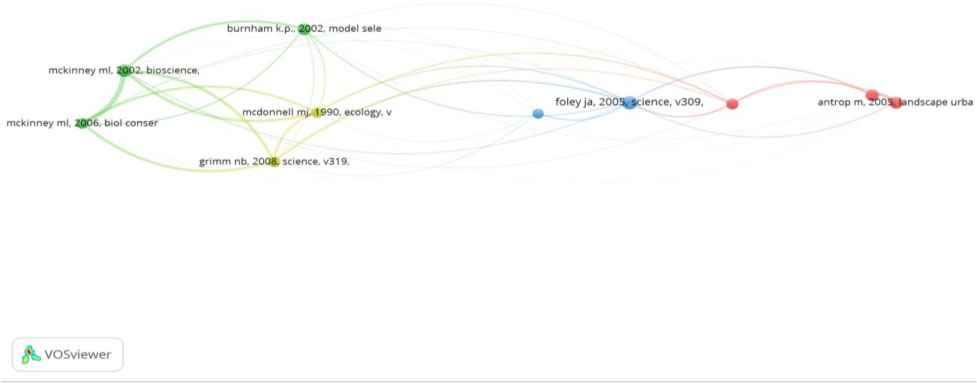
Cluster map of highly-cited documents in rural landscape research from 2002–2021.
3.5.1. Research Content Is Constantly Enriched
Research content will gradually deepen from external form to internal meaning. As external characteristics of the rural landscape are becoming more and more abundant, in addition to the research on its spatial environment, the content of the research should be expanded to a wider range. Through synergy between the urbanization process and rural landscapes as an important research path, the focus of the research will be shifted from the management and protection of rural landscapes to the coordinated development of urban regional development, rural landscapes, space, and biodiversity, to realize the mediating role of population urbanization. The topics of future research should not only focus on urban development, land use, vegetation research, etc., but also consider ecological balance, species protection, cultural construction, etc., and construct the symbolic meaning of rural public spaces to realize the relationship between their external form and internal meaning.
3.5.2. Research Field Continues to Expand
With the gradual enrichment of theoretical knowledge in various disciplines, research on rural landscapes should not only start with botany, ecology, and environmental sciences but also integrate economics, architecture, and information technology into its research. The cross-analysis of multidisciplinary fields makes use of in-depth analysis of rural landscapes and creative thinking. With the help of the unique advantages of different disciplines, the commonness and individuality of their theoretical research are explored, and the multi-dimensional research and development of rural landscape are realized and applied to the actual landscape space environment. At the same time, the research about related results will not be limited to a single professional field. The mixed research of multiple perspectives and fields can analyze the rural landscape space more scientifically and comprehensively and constantly update and integrate its landscape characteristics and patterns.
3.5.3. Continuous Innovation in Research Methods
The research method of the rural landscape should gradually shift from traditional humanistic thinking to emerging scientific and technological research and analyze the external structure of the entire rural environmental space through more rigorous and scientific theoretical methods. Starting from a subjective point of view is still the focus of research on the development of rural landscapes, but the use of objective data analysis to achieve reasonable transformation and management of rural landscapes should also attract attention. For example, remote sensing image RS, GIS, ENVI technology, etc., combines subjective perception with objective reality to achieve a comprehensive and systematic analysis and evaluation of the rural landscape. Maybe Naveh has an important point for future development when he says, “It is essential for landscape research to become an anticipating science, and like medicine, to become a prescriptive science” [26]. The research methods in this field will tend to be diversified and enriched, and the related scientific research results will provide a more systematic theoretical basis and practical application for improving the rural landscape environment and achieving ecological balance.
4. CONCLUSION
This article investigates the rural landscape research literature published in the Web of Science core database from 2002–2021 and visualizes keywords, disciplinary distribution, and highly cited literature of rural landscape research in recent decades by using VOSviewer analysis software. In addition, the clustering analysis was used to realize the sorting out of its hot topics and the prediction of future development trends, providing valuable references for future research activities in related fields.
Generally speaking, in recent decades, rural landscape research has shown a steady growth trend. The research hotspots mainly focus on landscape protection, land use, urbanization, and ecosystems. The distribution of research disciplines is mainly based on environmental science, ecology, geography, etc., showing the characteristics of multidisciplinary research distribution. Two of the most frequently cited documents in recent decades are the global consequences of land use and the importance of rural landscapes for the future. Both aim to explore the improvement of the rural landscape environment. From a long-term perspective, the future of related research mainly presents three major trends: the content of research gradually deepens from the external form to the internal meaning; the research discipline gradually deepens from a single discipline to multidisciplinary mixed research; and the research methods gradually change from subjective humanistic thinking development into objective scientific and technological practice.
In this article, the research results on rural landscapes in the past two decades are reviewed from a bibliometric perspective. Due to the limitations of the scope of articles included in the core collection of the Web of Science database, coupled with the analysis of measurement software, there is a certain degree of limitation. Subjectivity, there will be manual selection in the selection process. Although the collected samples, statistics, and conclusions do not reflect the full picture of rural landscape research in recent years, they do provide positive relevance for the study of rural landscape to a certain extent.
REFERENCES
Cite This Article

TY - CONF AU - Junhan Liu AU - Yang Zhao PY - 2023 DA - 2023/01/10 TI - A Bibliometric Analysis of the Development of Rural Landscape Research in the Past Twenty Years BT - Proceedings of the 4th International Conference on Architecture: Heritage, Traditions and Innovations (AHTI 2022) PB - Athena Publishing SP - 353 EP - 364 SN - 2949-8937 UR - https://doi.org/10.55060/s.atssh.221230.049 DO - https://doi.org/10.55060/s.atssh.221230.049 ID - Liu2023 ER -









